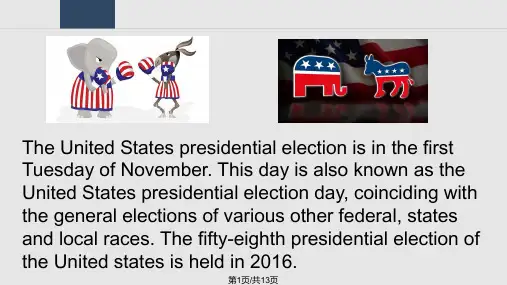美国大选英语PPT介绍希拉里和川普
- 格式:pptx
- 大小:4.84 MB
- 文档页数:14

希拉里和特朗普第一次辩论全文(英文)(5篇)第一篇:希拉里和特朗普第一次辩论全文(英文)Round One: Achieving Prosperity The question is about putting more money into the Americans’ pockets.First we have to build an economy that works for everyone, not just those at the top.That means we need more jobs, good jobs with rising incomes.I want us to invest in you.I want us to invest in your future.That means jobs in infrastructure and in mass manufacturing, in innovation and technology, clean renewable energy and in small businesses because most of the jobs will come from small business.We also have to make the economy fairer.That starts with raising the national minimum wage and also guarantee finely equal pay for women‘’s work.I also wane see more companies do profit sharing.If you helped make the profit you should be able to share them, not just the executives at the top.And I want us to do more to support people who are struggling to balance family and work.I’ve heard from so many of you about the difficulties you face and the stresses you' re under.And let’s have paid family leave, earned sick days.Let’s make sure we have affordable childcare and debt-free college.How are we gone do it ? We' re gonna do it by making the wealthy pay their fair share, close the corporate loopholes.Our jobs are fleeing the country.They are going to Mexico.They are going to many other countries.You look at what China' s doing to our country in terms of making our product.They ' re devaluing their currency and there ody in’ours government to fight them.And we have a very good fight and we have a winning fight because they are using our country as a piggy bank to rebuild China and many other countries are doingthe same thing.So we are losing our good jobs, so many of them.When you look at what' s happening in Mexico, one of my friend built a plant said it' s the eighth wonder of the world.They're building the big estsome of plants, anywhere in the world, some of the most sophisticated, some of thebest plants.With the United States, as you said, not so much.So Ford is leaving.You see, that, their small cars division, leaving.Thousands of jobs, leaving Michigan, leaving Ohio.They ' re all leaving.And we cannot allow it to happen anymore as far as childcare is concerned and so many other things.I think Hillary and I agree on that and we probably disagree on numbers and amounts and what we're going to do but perhaps we'll talk about that later.But we have to stop our jobs from being stolen from us.We have to stop our companies from leaving the United States, and with it, firing all of their people.All you have to do is take a look at the Carrier air-conditioning in Indianapolis.They left fired 1,400 people.They are going to Mexico.So many, hundreds and hundreds companies are doing this.We cannot let it happen.Under my plan, I' ll be reducing taxes tremendously from 35% to 15% for companies, small and big businesses.That 's gonna be a job creator, like, we haven't seen since Ronald Regan.It going to be a beautiful thing to panies will come.They will build.They will expand.New companies will start.And I look very very much forward to doing it.We have to renegotiate our trade deals.We have to stop these countries from stealing our companies and our jobs.Round Two: Let's T alk About Race Race remains a significant challenge in our country.Unfortunately race still determines too much.Often determines where people live.Determines what kind of education in their public schools they can get.And, yes, it determines howthey’re treated in the criminal justice system.We’ve just seen those tragic examples in both Tulsa and Charlotte.A nd we’got to do several things at the same time.We have to restore trust between communities and the police.We have to work to assure that our police are using the best training, the best technique, that they' re well prepared to use force only when necessary.Everyone should be respected by the law.And everyone should respect the law.Right now that’s not the case in a lot of our neighborhoods.So I have, ever since the first day of my campaign, called for criminal justice reform.I 've laid out a platform that I think will begin to remedy the problems we have in the criminal justice system.But we also have to recognize that in addition to the challenges we face with policing, there are so many brave, good police officers who equally want reform.So we have to bring communities together in order to work on that as a mutual goal.And we’ve got to get guns out of the hands of the people who should not have them.The gun epidemic is the leading cause of death of young African-American men, more than the next 9 causes put together.So we have to do 2 things as I said.We have to restore trust.We have to work with the police.We have to make sure they respect the communities and the communities respect them.And we have to tackle the plague of gun violence which is a contributor to a lot of problems we are seeing today.First of all, Secretary Clinton dosen law and order.We need law and order.We don't wanna use a couple of words.And that ' t have it.We are not gonna'twanna use a couple of words.And that' t have it.We are not gonna'twanna use a couple of words.And that’t have it.We are not gonna'have a country And when I look at what 's going on in Charlotte, the city I lovthe,city I have investments, when I look at what's going onthrough various parts of our country, whether it' s, I mean, I can just keep naming them all day long.We need law and order in our country.And I just got, today, the, eh you know, the endorsement, the fraternal order of police who just came in.We have endorsement from, I think, almost every police group, every, I mean, a lot percentage of them in the United States.We have a situation in which we have, eh, in the city, African-American, Hispanics are living in hell.Because it' s so dangerous.uYowalk down the street, you got shot.In Chicago, they' ve had thousands of shootings, thousands, since January 1st.Thousands of shootings.And I say: where is this? Is this a war-torn country.What are we doing? And we have to stop the violence.We have to bring back law and order in a place like Chicago where thousands of people have been killed, thousands, over the last number of years.In fact, almost 4,000 of people have been killed since Barack Obama became President.Over 4, almost 4,000 people have been killed in Chicago.We have to bring back law and order.Now, whether or not, in a place like Chicago, you do stop and frisk witch worked very well, Mary Julian is here, worked very well in New York.It brought the crime rate way down.But you take the gun away from criminals who shouldn't be having it.We have gangs roaming the street.And in many cases they' re illegally here, illegal immigrants.And they have guns.They shoot people.And we have to be very strong.We have to be very vigilant.We have to be, we have to know what we are doing.Right now our police, in many cases, are afraid to do anything.We have to protect our inner cities because African-American communities are being decimated by crime.Decimated!Round Three: Securing America Hillary:I think cyber security, cyber warfare will be one of the biggestchallenges facing the next president because clearly we are facing at this point 2 different kinds of ad versaries.There are the independent hacking groups that do, mostly, for commercial reasons to try to steal information that they can use to make money.But increasingly we are seeing cyber attacks coming from states, all kinds of states.The most recent and troubling of these are from Russia.There's no doubt now that Russia has used cyber attacks against all kinds of organizations in our country and I am deeply concerned about this.I know Donald' s, very, paise-worthy of Vladimir Putin.But Putin is playing a really tough long game here.And one of the things he's done is to let loose cyber attackers to hack into government files, to hack into personal files, hack into the Democratic National Committee.And we recently have learnt that, you know, this is one of their preferred methods of trying to wreak havoc and collect information.We need to make it very clear, whether it's Russia, China, Iran or anybody else.The United States has a much greater capacity and we are not gonna sit idly by and permit state actors to go after our information, our private sector information and our public sector information.And we are going to have to make it clear that we don' t want to use the kinds of tools that we have to engage in a different kind of warfare.But we will defend the citizens of this country.And the Russians need to understand that.I think they' ve been treating it as it is almost a probing.Howfar will we go? How much will we do? And that's why I was so, I was so shocked when Donald publicly invited Putin to hack into Americans.That is just unacceptable.That’s onereasonsofthewhy 15 national security officials who serve in Republican Information Administration have said that Donald is unfit to be the commander in chief.There’s comments like that really worrypeople who understand the threats that we face.Trump:Yeah, I do wanna say that I was just endorsed and more are coming the next week.It will be over 200 admirals, many of them are here, admirals and generals endorsed me to lead this country.That just happened and many more are coming.And I' m very proud of it.In addition I was just endorsed by ICE.They've never endorsed anybody before.On immigration I was just endorsed by ICE.I was just endorsed.7,500 patrol agents.So when Secretary Clinton talks about this I' ll take the admirals and I' ll t generals, any day over the political hacks that I see that has led our country so brilliantly over the last 10 years with their knowledge.Because look at the mess we' re in.Look at the mess we' re in.As long as there's the cyber, I agree to parts of what Secretary Clinton said.We should be better than anybody else and perhaps we’re not.I don't know if anybody knows that it's Russia that broke into the DNC.She saying Russia RussiaRussia.But I don't.Maybe it was.It could be Russia.But t could also be China.It could also be a lot of other people.Could also be somebody sitting on their bed that weighs 400 pounds, OK? You don' t know who broke into DNC.But what do we learn with DNC? We learnt that Bernie Sanders was taken advantage of by your people, by Debbie Wasserman Schultz.Look at what happened to her.But Bernie Sanders was taken advantage of.That's what we learned.Now, whether that was Russia, whether that was China, whether it was another country, we don't know, because the truth is, under President Obama we've lost control of things that we used to have control over.We came in with the Internet, we came up with the Internet, and I think Secretary Clinton and myself would agree very much, when you look at what ISIS is doing with the Internet, they're beating us at our owngame.ISIS.So we have to get very, very tough on cyber and cyber warfare.It is —it is a huge problem.I have a son.He's 10 years old.He has computers.He is so good with these computers, it's unbelievable.The security aspect of cyber is very, very tough.And maybe it's hardly doable.But I will say, we are not doing the job we should be doing.But that's true throughout our whole governmental society.第二篇:希拉里和特朗普第一次辩论(中英文)Round One: Achieving Prosperity 第一轮:实现繁荣主持人说:The question is about putting more money into the Americans’ pockets.问题是:如何让美国人的钱包鼓起来?首先发言的是希拉里:First we have to build an economy that works for everyone, not just those at the top.首先,我们要建立一个能为所有人服务的经济体,而非一个只为最富有那群人服务的。
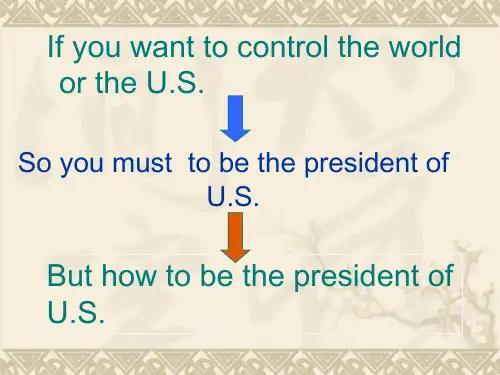
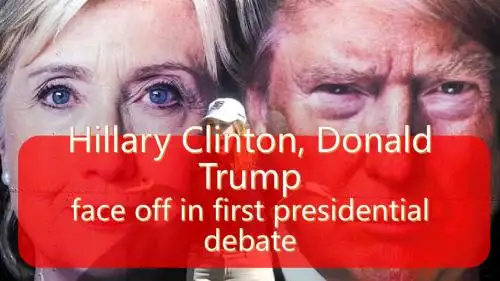
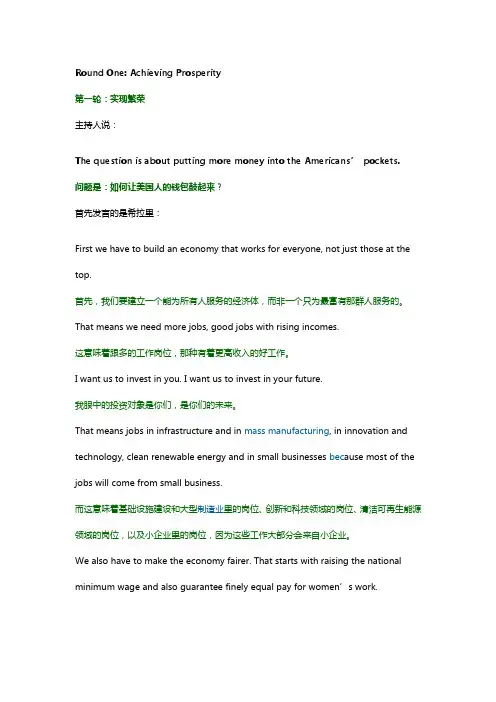
Round One: Achieving Prosperity第一轮:实现繁荣主持人说:The question is about putting more money into the Americans’pockets.问题是:如何让美国人的钱包鼓起来?首先发言的是希拉里:First we have to build an economy that works for everyone, not just those at the top.首先,我们要建立一个能为所有人服务的经济体,而非一个只为最富有那群人服务的。
That means we need more jobs, good jobs with rising incomes.这意味着跟多的工作岗位,那种有着更高收入的好工作。
I want us to invest in you. I want us to invest in your future.我眼中的投资对象是你们,是你们的未来。
That means jobs in infrastructure and in mass manufacturing, in innovation and technology, clean renewable energy and in small businesses bec ause most of the jobs will come from small business.而这意味着基础设施建设和大型制造业里的岗位、创新和科技领域的岗位、清洁可再生能源领域的岗位,以及小企业里的岗位,因为这些工作大部分会来自小企业。
We also have to make the economy fairer. That starts with raising the national minimum wage and also guarantee finely equal pay for women’s work.我们还得让经济环境更加公平。
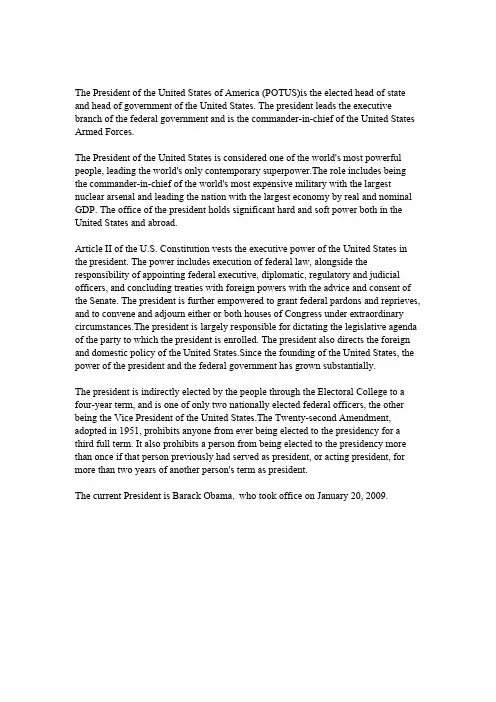
The President of the United States of America (POTUS)is the elected head of state and head of government of the United States. The president leads the executive branch of the federal government and is the commander-in-chief of the United States Armed Forces.The President of the United States is considered one of the world's most powerful people, leading the world's only contemporary superpower.The role includes being the commander-in-chief of the world's most expensive military with the largest nuclear arsenal and leading the nation with the largest economy by real and nominal GDP. The office of the president holds significant hard and soft power both in the United States and abroad.Article II of the U.S. Constitution vests the executive power of the United States in the president. The power includes execution of federal law, alongside the responsibility of appointing federal executive, diplomatic, regulatory and judicial officers, and concluding treaties with foreign powers with the advice and consent of the Senate. The president is further empowered to grant federal pardons and reprieves, and to convene and adjourn either or both houses of Congress under extraordinary circumstances.The president is largely responsible for dictating the legislative agenda of the party to which the president is enrolled. The president also directs the foreign and domestic policy of the United States.Since the founding of the United States, the power of the president and the federal government has grown substantially.The president is indirectly elected by the people through the Electoral College to a four-year term, and is one of only two nationally elected federal officers, the other being the Vice President of the United States.The Twenty-second Amendment, adopted in 1951, prohibits anyone from ever being elected to the presidency for a third full term. It also prohibits a person from being elected to the presidency more than once if that person previously had served as president, or acting president, for more than two years of another person's term as president.The current President is Barack Obama,who took office on January 20, 2009.The President of China is the head of state of the People's Republic of China . On paper, the presidency is a largely ceremonial office with limited powers. However, in recent years the General Secretary of the Communist Party has also served simultaneously as President. In Chinese politics, the election to the post of party leader marks his ascension as paramount leader of the country rather than the presidency.The office is classified as an institution of the state rather than an administrative post.According to the current Constitution of the People's Republic of China, the President must be a Chinese citizen with full electoral rights who has reached the age of 45. The President's term of office is the same as the term of the National People's Congress (currently five years), and the president and vice-president are both limited to two consecutive terms.The President is elected by the National People's Congress (NPC), China's highest state body, which also has the power to remove the President and other state officers from office. Elections and removals are decided by a simple majority vote.According to the Organic Law of the NPC, the President is nominated by the NPC Presidium, the Congress's executive organ.In practice, however, the ruling Communist Party of China reserves the post of President for its current General Secretary. Like all officers of state elected by the NPC, the President is elected from a one name ballot.In the event that the office of President falls vacant, the Vice-President succeeds to the office. In the event that both offices fall vacant, the Chairman of the NPC Standing Committee temporarily acts as President until the NPC can elect a new President and Vice-President.Under the present Chinese constitution, the Presidency is a prestigious but largely ceremonial position holding few powers in its own right, most significantly the right to nominate the Premier. Most of the few powers the President does possess are subject to the approval of the National People's Congress, by whom the President is elected for up to two terms of five years each.The current President is Xi Jinping, who took office on 14 March 2013.The President of the United States is a real job, master the country's highest administrative power and military power; and the president of China is the virtual level, have no real power.It is fixed with another identity, that the CPC Central Committee General Secretary and Chairman of the Central Military Commission, the latter of these two powers is more practical significance.From the internal point of view of power, The President of China have greater powers than The President of the United States Separation of powers Because the US is the State President to the administrative authority and military power, subject to legislative and judicial power; and Chinese President consul all domestic power status by the General Secretary of the CPC Central Committee, including the legislative and judicial powers, We are subject to the "leadership of the party." Of course, this power is moderate, the general secretary not directly flagrant intervention legislative and judicial, administrative authority nor can (executive power belongs to the Prime Minister). But from the coverage of power, the Chinese President will undoubtedly be greater.From the outside powers,president of the United States Constitution to be strictly limited internal power, while the president's foreign affairs power to loose more, especially on the military operation authority, much higher than the Chinese President. In contrast, the Chinese President has no authority outside the Chinese army decision to launch a military action must be decided by the NPC.1. China's top military and political power is divided into, respectively, the General Secretary and State President and CMC Chairman2. The United States is divided into supreme power, legislative, judicial, administrativethe president of China , the Chinese government and army put together in one person from 1992 on wards, and therefore, the current president is rolled into the three powers.The President of the United States is the highest office of the executive, legislative vice president is usually the highest office, the judiciary is the highest office of the Chief Justice.The difference between them:1. The President of the Congress oversight bodies, namely the legislature, the president's decision is entitled to raise objections. China's watchdog Commission for Discipline Inspection, do some corruption, but no decision-making powers of supervision.2. From the point of view of military power to mobilize the The President of the United States can mobilize armies, The President of the china in 1992 years before the transfer does not move, but now the three powers in the hands of the President be able to tune the dynamic, they have same basically power.3. In the judicial system, the The President of the United States did not have permission to intervene, and The President of the china, the Politics and LawCommittee of the boss, right to intervene in the judicial system. But the The President of the United States has immunity, but in China the The President of the china do not has immunity.4. The United States legislation Congress, China's legislature is the National People's Congress, is the highest executive chairman. The President of the United States does not substantially interfere legislature, The President of the china is chairman of the boss, the right to intervene legislation.。
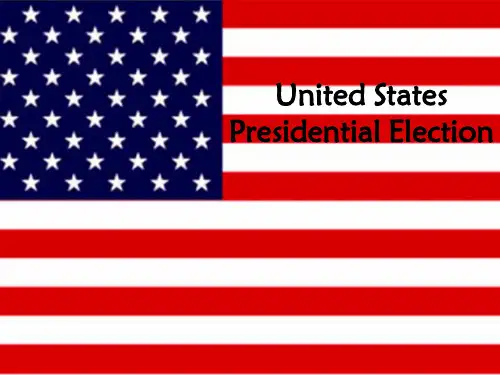
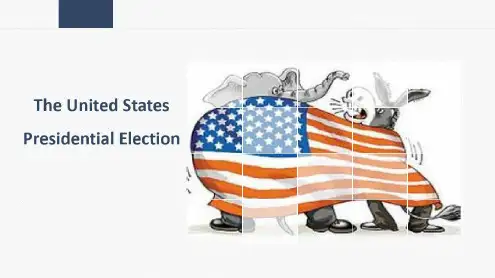
The United States-Presidential ElectionThe United States presidential election is in the first-Tuesday of Novemb r.This day is also known as the-United States presidential election day,c inciding with-the general elections of various other federal,states-and l cal races.The fifty-eighth presidential election of-the United states is eld in 2016.PRESIDENTIAL-ELECTION-1-History-2-Procedure-3-trends-CandidateHistory-Constitutionally,the manner for choosing electors is determined-w thin each state by its legislature.During the first presidential-election in 1789,only 6 of the 13 original states chose electors-by any form of po ular vote.Gradually throughout the years,-the states began conducting pop lar elections to help choose-their slate of electors,resulting in the ove all,nationwide-indirect election system that it is today.History-The election of the President and the Vice President of the-Unite States is an indirect vote in which citizens cast ballots for-a slate of members of the U.S.Electoral College;these electors-in turn directly elec the President and Vice President.procedure-Sn92015-Candidates announce their intentions to run,-andif nece saryfile their Statement of-Candidacy with the Federal Election-Commissio -Eligibility requirements-March 2016-Primary and caucus debates-February to June 14,2016-Primaries and-caucuses-Nominating process-August 2015 to April to August,2016-Nominating-conventionsincluding those of the minor t ird-parties-3-The popular vote-on Election Day-Presidential election deba es-Electoral college-October,2016-September and-November 8,2016-Election ay-January,2017-2016 and Early-December,-Electors cast their electoral vo es-Congress counts and certifies the electoral-January 20,2017-Inaugurati n DayThe Procedure-National Representatives-Conference-January June July Augus November-Primary election-Running-Inaugural-address-ElectionTrends-Political experience-In recent decades,the presidential-nominees o both major parties have-been either incumbent presidents,-sitting or for er vice presidents,-sitting or former U.S.Senators,or-sitting or former s ate Governors.-Technology and media-Advances in technology and media-have also affected presidential-campaigns.The invention of both-radio and tele ision have given way-to the reliance of national political-advertisements across those-methods of communication.Candidates of 2016-Hillary Clinton-Donald Trump-Deocratic Party-Republic artyThe winner is...-Donald Trump-Republic PartyInaugural Address-President I do solemnly swear that I will-faithfully ex cute the office of President of the-YKESIDENT OF THE UNITE-United States, nd will to the best of my ability,-preserve,protect,and defend the Consti ution-of the United-States.。
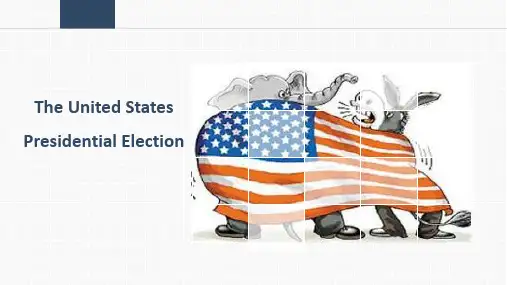
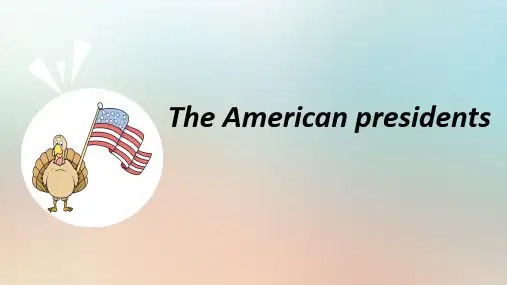
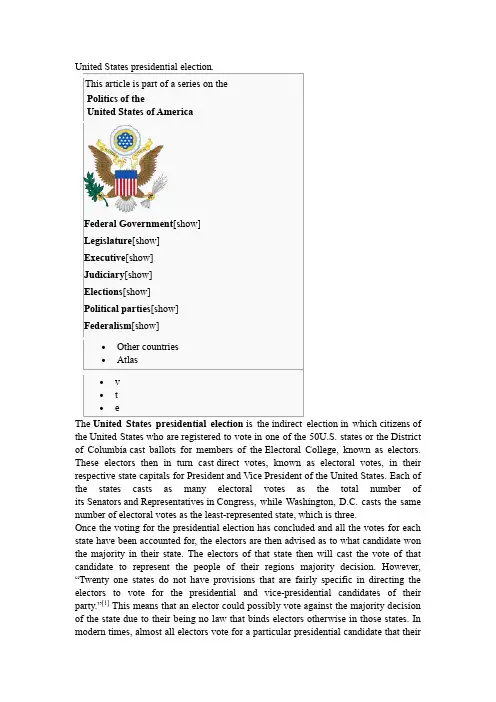
election in which citizens of the United States who are registered to vote in one of the 50U.S. states or the District of Columbia cast ballots for members of the Electoral College, known as electors. These electors then in turn cast direct votes, known as electoral votes, in their respective state capitals for President and Vice President of the United States. Each of the states casts as many electoral votes as the total number of its Senators and Representatives in Congress, while Washington, D.C. casts the same number of electoral votes as the least-represented state, which is three.Once the voting for the presidential election has concluded and all the votes for each state have been accounted for, the electors are then advised as to what candidate won the majority in their state. The electors of that state then will cast the vote of that candidate to represent the people of their regions majority decision. However, “Twenty one states do not have provisions that are fairl y specific in directing the electors to vote for the presidential and vice-presidential candidates of their party.”[1] This means that an elector could possibly vote against the majority decision of the state due to their being no law that binds electors otherwise in those states. In modern times, almost all electors vote for a particular presidential candidate that theirstates majority decided upon; thus, the results of the election can generally be determined based on the state-by-state popular vote. The candidate who receives an absolute majority of electoral votes for President or Vice President (currently, at least 270 out of a total of 538) is then projected to be elected to that office. If no candidate receives an absolute majority of electoral votes for President, the House of Representatives chooses the President; if no candidate receives an absolute majority for Vice President, the Senate chooses the Vice President.These presidential elections occur quadrennially. Registered voters cast their ballots on Election Day, which since 1845 has been the Tuesday after the first Monday in November (i.e.,the first Tuesday after November 1),[2][3][4] coinciding with the general elections of various other federal, state, and local races. The Electoral College electors then schedule to formally cast their electoral votes on the first Monday after the second Wednesday of December (i.e., the first Monday after December 12) at their respective state capitals. Congress then certify the results in early January, and the presidential term begins on Inauguration Day, which since the passage of the Twentieth Amendment has been set at January 20.The Electoral College and its procedure is established in the U.S. Constitution by Article II, Section 1, Clauses 2 and 4; and the Twelfth Amendment(which replaced Clause 3 after it was ratified in 1804). Under Article II, Section 1, Clause 2, the manner for choosing electors is determined by each state legislature, not directly by the federal government. Many state legislatures used to select their electors directly instead of using any form of popular vote, but the political parties in the various states now conduct their own separate elections to help choose their slate of electors. The Twenty-third Amendment, ratified in 1961, then granted electoral votes to Washington, D.C. Electors can vote for anyone, butunpledged electors or faithless electors have been rare in modern times.The nomination process, consisting of the primary elections and caucuses and the nominating conventions, was not specified in the Constitution, but was developed over time by the states and thepolitical parties. These primary elections are generally held between January and June before the general election in November, while the nominating conventions are held in the summer. This too is an indirect election process, one in which voters in the various states, the District of Columbia, as well as those in U.S. territories, cast ballots for a slate of delegates to a political party's nominating convention, who then in turn elect their party's presidential nominee. Each party's presidential nominee or the convention may then choose a vice presidential running mate to join with him or her on the same ticket, and this choice is often rubber-stamped by the conventions, depending on that convention's rules. Because of changes to national campaign finance laws since the 1970s regarding the disclosure of contributions for federal campaigns, presidential candidates from the major political parties usually declare their intentions to run as early as the spring of the previous calendar year before the election (almost 18 months before Inauguration Day).[5]A 2016 general election ballot, listing the presidential and vice presidential candidates Contents[hide]∙1History∙2Procedureo 2.1Eligibility requirementso 2.2Nominating processo 2.3The popular vote on Election Dayo 2.4Electoral collegeo 2.5Election calendar∙3Trendso 3.1Previous experienceo 3.2Technology and media∙4Criticismso 4.1Proposed changes to the election process∙5Electoral college results∙6V oter turnout∙7Financial disclosures∙8Presidential coattailso8.1Comparison with other U.S. general elections∙9See also∙10Notes∙11External linksHistory[edit]Article Two of the United States Constitution originally established the method of presidential elections, including the Electoral College. This was a result of a compromise between those constitutional framers who wanted the Congress to choose the president, and those who preferred a national popular vote.[6]Each state is allocated a number of electors that is equal to the size of its delegation in both houses of Congress combined. With the ratification of the 23rd Amendment to the Constitution in 1961, the District of Columbia is also granted a number of electors, equal to the number of those held by the least populous state. However, U.S. territories are not represented in the Electoral College.Constitutionally, the manner for choosing electors is determined within each state by its legislature. During the first presidential election in 1789, only 6 of the 13 original states chose electors by any form of popular vote.[7] Gradually throughout the years, the states began conducting popular elections to help choose their slate of electors, resulting in the overall, nationwide indirect election system that it is today.Under the original system established by Article Two, electors could cast two votes to two different candidates for president. The candidate with the highest number of votes (provided it was a majority of the electoral votes) became the president, and the second-place candidate became the vice president. This presented a problem during the presidential election of 1800 when Aaron Burrreceived the same number of electoral votes as Thomas Jefferson and challenged Jefferson's election to the office. In the end, Jefferson was chosen as the president because of Alexander Hamilton's influence in the House of Representatives. This added to the deep rivalry between Burr and Hamilton which resulted in their famous 1804 duel.In response to the 1800 election, the 12th Amendment was passed, requiring electors to cast two distinct votes: one for President and another for Vice President. While this solved the problem at hand, it ultimately had the effect of lowering the prestige of the Vice Presidency, as the office was no longer for the leading challenger for the Presidency. The separate ballots for President and Vice President became something of a moot issue later in the 19th century when it became the norm for popular elections to determine a state's Electoral College delegation. Electors chosen this way are pledged to vote for a particular presidential and vice presidential candidate (offered by the same political party). So, while the Constitution says that the President and Vice President are chosen separately, in practice they are chosen together.The 12th Amendment also established rules when no candidate wins a majority vote in the Electoral College. In the presidential election of 1824, Andrew Jackson received a plurality, but not a majority, of electoral votes cast. The election was thrown to the House of Representatives, and John Quincy Adams was elected to the presidency. A deep rivalry resulted between Andrew Jackson and House Speaker Henry Clay, who had also been a candidate in the election.Since 1824, aside from the occasional "faithless elector," the popular vote determines the winner of a presidential election by determining the electoral vote, as each state or district's popular vote determines its electoral college vote. Although the nationwide popular vote does not directly determine the winner of a presidential election, it does strongly correlate with who is the victor. In 52 of the 56 total elections held so far (about 93 percent), the winner of the national popular vote has also carried the Electoral College vote. The winners of the nationwide popular vote and the Electoral College vote differ only in close elections. In highly competitive elections, candidates focus on turning out their vote in the contested swing states critical to winning an electoral college majority, so they do not try to maximize their popular vote by real or fraudulent vote increases in one-party areas.[8]However, candidates can fail to get the most votes in the nationwide popular vote in a Presidential election and still win that election. In the 1824 election, Jackson won the popular vote, but no one received the majority of electoral votes. According to the12th Amendment in the Constitution, the House of Representatives must choose the president out of the top 3 people in the election. Clay had come fourth, so he threw his support to Adams, who then won. Because Adams later named Clay his Secretary of State, Jackson's supporters claimed that Adams gained the presidency by making a deal with Clay. Charges of a "corrupt bargain" followed Adams through his term.Comparison of the popular vote totals since 1900.RepublicanDemocratAll other candidates togetherThen in 1876, 1888, 2000, and 2016, the winner of electoral vote lost the popular vote outright. Numerous constitutional amendments have been submitted seeking to replace the Electoral College with a direct popular vote, but none has ever successfully passed both Houses of Congress. Another alternate proposal is the National Popular V ote Interstate Compact, an interstate compact whereby individual participating states agree to allocate their electors based on the winner of the national popular vote instead of just their respective statewide results.The presidential election day was established on a Tuesday in the month of November because of the factors involved (weather, harvests and worship). When voters used to travel to the polls by horse, Tuesday was an ideal day because it allowed people to worship on Sunday, ride to their county seat on Monday, and vote on Tuesday–all before market day, Wednesday. The month of November also fits nicely between harvest time and harsh winter weather, which could be especially bad to people traveling by horse and buggy.[9]Until 1937, presidents were not sworn in until March 4 because it took so long to count and report ballots, and because of the winner's logistical issues of moving to the capital. With better technology and the 20th Amendment being passed, presidential inaugurations were moved to noon on January 20–allowing presidents to start their duties sooner.[9]The Federal Election Campaign Act of 1971 was enacted to increase disclosure of contributions for federal campaigns. Subsequent amendments to law require that candidates to a federal office must file a Statement of Candidacy with the Federal Election Commission before they can receive contributions aggregating in excess of $5,000 or make expenditures aggregating in excess of $5,000. Thus, this began a trend of presidential candidates declaring their intentions to run as early as the Spring of the previous calendar year so they can start raising and spending the money needed for their nationwide campaign.[5]The first president, George Washington, was elected as an independent. Since the election of his successor, John Adams, in 1796, all winners of U.S. presidential elections have represented one of two major parties. Third parties have taken secondplace only twice, in 1860 and 1912. The last time a third (independent) candidate achieved significant success (although still finishing in third place) was in 1992, and the last time a third-party candidate received any electoral votes not from faithless electors was in 1968.Procedure[edit]Eligibility requirements[edit]The hand-written copy of the natural-born-citizen clause as it appeared in 1787 Article Two of the United States Constitution stipulates that for a person to serve as President, the individual must be a natural-born citizen of the United States, at least35 years old, and a resident of the United States for a period of no less than 14 years.A candidate may start running his or her campaign early before turning 35 years old or completing 14 years of residency, but must meet the age and residency requirements byInauguration Day. The Twenty-second Amendment to the Constitution also sets a term limit: a President cannot be elected to more than two terms.The U.S. Constitution also has two provisions that apply to all federal offices in general, not just the presidency. Article I, Section 3, Clause 7 states that if the U.S. Congress convicts any officer on impeachment, they may also bar that person from holding any public office in the future. And Section 3 of the Fourteenth Amendment prohibits the election to any federal office of any person who had held any federal or state office and then engaged in insurrection, rebellion or treason; this disqualification can be waived if such an individual gains the consent of two-thirds of both houses of Congress.In addition, the Twelfth Amendment establishes that the Vice-President must meet all of the qualifications of being a President.Although not a mandatory requirement, Federal campaign finance laws including the Federal Election Campaign Act state that a candidate who intends to receive contributions aggregating in excess of $5,000 or make expenditures aggregating in excess of $5,000, among others, must first file a Statement of Candidacy with the Federal Election Commission.[10] This has led presidential candidates, especially members from the two major political parties, to officially announce their intentions to run as early as the spring of the previous calendar year so they can start raising or spending the money needed for their nationwide campaign.[5] Potential candidates usually form exploratory committees even earlier to determining the feasibility of them actually running.Nominating process[edit]Main articles: United States presidential primary and United States presidential nominating conventionA 2008 Democratic caucus meeting in Iowa City, Iowa. The Iowa caucuses are traditionally the first major electoral event of presidential primaries and caucuses.Madison Square Garden in New York City, the site of the 1976, 1980, and 1992 Democratic National Conventions; and the 2004 Republican National Convention.The floor of the 2008 Republican National Convention at the Xcel Energy Center in Saint Paul, Minnesota.The modern nominating process of U.S. presidential elections consists of two major parts: a series of presidential primary elections and caucuses held in each state, and the presidential nominating conventions held by each political party. This process was never included in the United States Constitution, and thus evolved over time by the political parties to clear the field of candidates.The primary elections are run by state and local governments, while the caucuses are organized directly by the political parties. Some states hold only primary elections, some hold only caucuses, and others use a combination of both. These primaries and caucuses are staggered generally between January and June before the federal election, with Iowa and New Hampshire traditionally holding the first presidential state caucus and primary, respectively.Like the general election, presidential caucuses or primaries are indirect elections. The major political parties officially vote for their presidential candidate at their respective nominating conventions, usually all held in the summer before the federal election. Depending on each state's law and state's political party rules, when voters cast ballots for a candidate in a presidential caucus or primary, they may be voting to awarddelegates "bound" to vote for a candidate at the presidential nominating conventions, or they may simply be expressing an opinion that the state party is not bound to follow in selecting delegates to their respective national convention.Unlike the general election, voters in the U.S. territories can also elect delegates to the national conventions. Furthermore, each political party can determine how many delegates to allocate to each state and territory. In 2012 for example, the Democratic and Republican party conventions each used two different formulas to allocate delegates. The Democrats-based theirs on two main factors: the proportion of votes each state gave to the Democratic candidate in the previous three presidential elections, and the number of electoral votes each state had in the Electoral College.[11] In contrast, the Republicans assigned to each state 10 delegates, plus 3 delegates per congressional district.[12] Both parties then gave fixed amounts of delegates to each territory, and finally bonus delegates to states and territories that passed certain criteria.[11][12]Along with delegates chosen during primaries and caucuses, state and U.S. territory delegations to both the Democratic and Republican party conventions also include "unpledged" delegates that have a vote. For Republicans, they consist of the three top party officials from each state and territory. Democrats have a more expansive group of unpledged delegates called "superdelegates", who are party leaders and elected officials.Each party's presidential candidate also chooses a vice presidential nominee to run with him or her on the same ticket, and this choice is rubber-stamped by the convention.If no single candidate has secured a majority of delegates (including both pledged and unpledged), then a "brokered convention" results. All pledged delegates are then "released" and are able to switch their allegiance to a different candidate. Thereafter, the nomination is decided through a process of alternating political horse trading, and additional rounds of re-votes.[13][14][15][16]The conventions have historically been held inside convention centers, but since the late 20th century both the Democratic and Republican parties have favoredsports arenas and domed stadiums to accommodate the increasing attendance.The popular vote on Election Day[edit]A Texas voter about to mark a selection for president on a ballot, 2008 Election Day Under the United States Constitution, the manner of choosing electors for the Electoral College is determined by each state's legislature. Although each state designates electors by popular vote, other methods are allowed. For instance, insteadof having a popular vote, a number of states used to select presidential electors by a direct vote of the state legislature itself.However, federal law does specify that all electors must be selected on the same day, which is "the first Tuesday after the first Monday in November," i.e., a Tuesday no earlier than November 2 and no later than November 8.[17] Today, the states and the District of Columbia each conduct their own popular elections on Election Day to help determine their respective slate of electors. Thus, the presidential election is really an amalgamation of separate and simultaneous state elections instead of a single national election run by the federal government.Like any other election in the United States, the eligibility of an individual for voting is set out in the Constitution and regulated at state level. The Constitution states that suffrage cannot be denied on grounds of race or color, sex or age for citizens eighteen years or older. Beyond these basic qualifications, it is the responsibility of state legislatures to regulate voter eligibility.Generally, voters are required to vote on a ballot where they select the candidate of their choice. The presidential ballot is a vote "for the electors of a candidate" meaning that the voter is not voting for the candidate, but endorsing a slate of electors pledged to vote for a specific presidential and vice presidential candidate.Many voting ballots allow a voter t o “blanket vote” for all candidates in a particular political party or to select individual candidates on a line by line voting system. Which candidates appear on the voting ticket is determined through a legal process known as ballot access. Usually, the size of the candidate's political party and the results of the major nomination conventions determine who is pre-listed on the presidential ballot. Thus, the presidential election ticket will not list every candidate running for President, but only those who have secured a major party nomination or whose size of their political party warrants having been formally listed. Laws are in effect to have other candidates pre-listed on a ticket, provided that enough voters have endorsed the candidate, usually through a signature list.The final way to be elected for president is to have one's name written in at the time of election as a write-in candidate. This is used for candidates who did not fulfill the legal requirements to be pre-listed on the voting ticket. It is also used by voters to express a distaste for the listed candidates, by writing in an alternative candidate for president such as Mickey Mouse or comedian Stephen Colbert (whose application was voted down by the South Carolina Democratic Party). In any event, a write-in candidate has never won an election for President of the United States.Because U.S. territories are not represented in the Electoral College, U.S. citizens in those areas do not vote in the general election for President. Guam has held straw polls for president since the 1980 election to draw attention to this fact.[18]Electoral college[edit]Main article: Electoral College (United States)Electoral College map showing the results of the 2016 U.S. presidential election. Republican candidate Donald Trump won the popular vote in 30 states (denoted in red) to capture 305 electoral votes (plus 1 electoral vote from Maine's second congressional district). Democraticcandidate Hillary Clinton won the popular vote in 20 states and Washington, D.C. (denoted in blue) to capture 232 electoral votes.Most state laws establish a winner-take-all system, wherein the ticket that wins a plurality of votes wins all of that state's allocated electoral votes, and thus has their slate of electors chosen to vote in the Electoral College. Maine and Nebraska do not use this method, instead giving two electoral votes to the statewide winner and one electoral vote to the winner of each Congressional district.Each state's winning slate of electors then meets at their respective state's capital on the first Monday after the second Wednesday in December to cast their electoral votes on separate ballots for President and Vice President. Although Electoral College members can technically vote for anyone under the U.S. Constitution, 24 states have laws to punish faithless electors,[19] those who do not cast their electoral votes for the person whom they have pledged to elect.In early January, the total Electoral College vote count is opened by the sitting Vice President, acting in his capacity as President of the Senate, and read aloud to a joint session of the incoming Congress, which was elected at the same time as the President.If no candidate receives a majority of the electoral vote (at least 270), the President is determined by the rules outlined by the 12th Amendment. Specifically, the selection of President would then be decided by a contingent election in a ballot of the House of Representatives. For the purposes of electing the President, each state has only one vote. A ballot of the Senate is held to choose the Vice President. In this ballot, each senator has one vote. The House of Representatives has chosen the victor of the presidential race only twice, in 1800 and 1824; the Senate has chosen the victor of the vice-presidential race only once, in 1836.If the President is not chosen by Inauguration Day, the Vice President-elect acts as President. If neither are chosen by then, Congress by law determines who shall act as President, pursuant to the 20th Amendment.Unless there are faithless electors, disputes, or other controversies, the events in December and January mentioned above are largely a formality since the winner canbe determined based on the state-by-state popular vote results. Between the general election and Inauguration Day, this apparent winner is referred to as the "President-elect" (unless it is a sitting President that has won re-election).Election calendar[edit]The typical periods of the presidential election process are as follows, with the dates corresponding to the 2016 general election:∙Spring 2015 – Candidates announce their intentions to run, and (if necessary) file their Statement of Candidacy with the Federal Election Commission ∙August 2015 to March 2016 – Primary and caucus debates∙February 1 to June 14, 2016 – Primaries and caucuses∙April to August, 2016 – Nominating conventions (including those of the minor third parties)∙September and October, 2016 – Presidential election debates∙November 8, 2016 – Election Day∙December 19, 2016 – Electors cast their electoral votes∙January 6, 2017 – Congress counts and certifies the electoral votes∙January 20, 2017 – Inauguration DayTrends[edit]Previous experience[edit]See also: List of Presidents of the United States by previous experience and List of Presidents of the United States by other offices heldJohn Adams was the first of a record-high 26 presidents who had been lawyersA number of trends in the political experience of presidents have been observed. Between 1956 and the last completed 2012 election, the presidential nominees of both major parties have been either incumbent presidents seeking re-election, sitting or former vice presidents, sitting or former U.S. Senators, or sitting or former state Governors.Fourteen Presidents have served as Vice President. However, only John Adams (1796), Thomas Jefferson (1800), Martin Van Buren (1836), Richard Nixon (1968) andGeorge H. W. Bush (1988) began their first term after winning an election. Among the remaining nine who began their first term as President according to thepresidential line of succession after their respective predecessor died or resigned from office, Theodore Roosevelt, Calvin Coolidge, Harry S. Truman, andLyndon B. Johnson were reelected. John Tyler, Millard Fillmore, Andrew Johnson, Chester A. Arthur, and Gerald Ford served as President but became president through succession and not election. Ford became President after Nixon's resignation in 1974 through the processes of the Twenty-fifth Amendment and then lost the 1976 presidential election, making him the only President to have not to have been elected to national office. Sixteen presidents had served in the Senate, including four of the five Presidents who served between 1945 and 1974. However, only three were sitting U.S. Senators at the time they were elected president (Warren G. Harding in 1920, John F. Kennedy in 1960, and Barack Obama in 2008). Major-party candidate Senators Andrew Jackson (1824), Lewis Cass (1848), Stephen Douglas (1860), Barry Goldwater (1964), George McGovern (1972), John Kerry (2004), and John。
